
It's no secret: Indians don't need a reason to celebrate. Whether it is taking a holy dip in the Ganges or dancing in the Himalayas, we simply love to let our hair down. And the fact that we have so many cultures and religions co-existing makes India an even merrier place to live in.
Rediff.com lists out some of the best-known festivals and fairs that are to be held through 2010 in India.
JANUARY
The Kumbh Mela (Haridwar, Uttarakhand)
January 14 to April 28
Perhaps the largest religious (or otherwise) gathering in the world, the Kumbh Mela is a festival that is most revered of all festivities in India. Sages and pilgrims from across the country gather at Haridwar and take a holy dip in the Ganges to wash away their sins. The Mela consists of many 'snans' or holy dips, the first of which happened on January 14 and the fair is currently underway.
Even as it is one of the most pious of all the festivals, the concept of the Kumbh Mela has become something of a joke in pop culture thanks to Bollywood movie characters who often refer to it (with tongues firmly in their cheek) as the place where they lost their sibling.
Republic Day (New Delhi)
January 26
A colourful, military parade and floats from each state move down Rajpath, New Delhi, and daredevil fly past, attended by the President and prime minister marks the celebration of India's statehood every year on January 26. Officially, the festivity ends on January 29, with the Beating of the Retreat.
If you think we've missed out on any important festive celebration, please do update the messageboard below so that other readers can benefit from the information -- and do remember to mention the date!
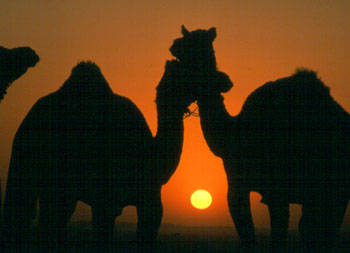
Jaipur Literary Festival (Jaipur, Rajasthan)
January 21-January 25
It's where the best-known minds of contemporary literature meet and debate. Sure you may argue that the debates don't lead anywhere but hey imagine bumping into Salman Rushdie over lunch or VS Naipaul over tea! Not such a bad way to start the year, is it?
Hampi Festival (Hampi, Karnataka)
January 27-January 29
Built on the banks of the river Tungabhadra, Hampi was the capital city of the Vijayanagar Empire and is listed as one of the UNESCO World Heritage Sites.
The festival of Hampi with dance, music, fireworks and processions hopes to recreate the splendour of city against its ruins. Usually the festival is held in November but this year is the 500th anniversary of the coronation of the much-revered king of the Vijaynagar Empire, Krishna Devaraya (1509 to 1529), and hence the January festivities.
Desert Festival (Jaisalmer)
January 28-January 30
Colourful bazaars, camel races, traditional puppet shows, fire dance and folk music and dance programmes, the desert definitely doesn't get more interesting in India than this.
Some of the highlights of this competition include turban tying contests, the sound and light show and folk artists performing against the sand dunes in Sam.

Surajkund Crafts Mela (Haryana)
February 1-February 15
The popular mela or fair is a platform for folk artistes and artisans from across the country to display their talent. A shopper's paradise, the Surajkund Crafts Mela has a state for a theme each year. This year will be Rajasthan's turn. With the growing the number of states in India, the mela sure won't run out of states to feature.
Khajuraho Dance Festival (Khajuraho, Madhya Pradesh)
1 February - February 7
Home to India's most erotic sculptures, the Khajuraho temple grounds play host to an exhilarating Festival of Dances each year.
The festival is hosted by the Madhya Pradesh State Tourism Development Corporation and showcases the most prominent exponents of various Indian classical dances.
Mahashivratri (Across India)
February 12, 2010
It is supposed to be the night Lord Shiva danced his frenzied tandava or celestial dance of destruction. On this day Shiva temples across the country are crowded as devotees flock for the blessings of the deity. If you're in Mumbai and are adventurous enough you could try and visit the Babulnath Temple in South Mumbai. The Mahakaleswar Temple at Ujjain also sees a special celebration as does Mandi in Himachal Pradesh.
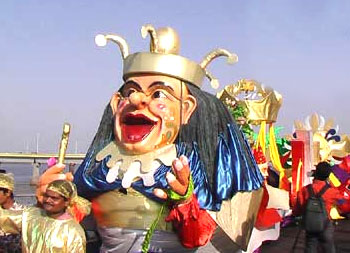
Goa Carnival (Panaji, Goa)
February 13-February 16
It's officially the last day of festivity and celebrations before Lent. The Goa Carnival is held in Panaji, the capital of Goa. Fancy dress balls, floats, parades and a frenetic round of dancing, drinking and feasting mark the celebrations as highlight of the festivities 'King Momo' the officially appointed festival ruler parades through the city streets.
Taj Mahotsav (Agra, Uttar Pradesh)
February 18-February 27
The festival is organised at Shilpigram, which is close to the Taj Mahal. It's where some 400-odd artisans display their art. Taj Mahotsav also has a lot of cultural festivities where performers from across the country display their folk and classical art forms. With the Taj Mahal as the backdrop, surely nothing could be better, could it?
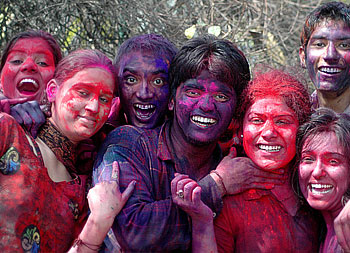
Holi (Across India)
March 1
Holi the festival of colours is celebrated across the India with a few variations here and there. But if there is a place to be in India during Holi it is the village of Barsana near Mathura in Uttar Pradesh.
Barsana hosts something called the Lath mar Holi where women beat up men with sticks. Of course the men protect themselves with shields. But it's a sight to watch sari-clad women having the time of their lives in this rather amusing ritual. After all no one's going to sue you if you miss a stroke.
Nauchandi Mela (Meerut, Uttar Pradesh)
A classic example of religious tolerance is the Nauchandi Mela, a festival that is held near the Hindu Nauchandi temple and the Muslim shrine of Bala Mian.
Legend has it that the month-long fair that starts soon after Holi, first started as a one-day trade fair for cattle traders back in 1627. Since then it has been each year growing in stature except in 1858 when the city saw the revolt against the East India Company.
Gudi Padwa (All over Maharashtra)
March 16
The New Year's Day in the Marathi calendar, Gudi Padwa is supposed to mark the beginning of spring. Maharashtrians consider this day as one of the three and a half most auspicious days when every moment is favourable to start a new activity.
It is celebrated throughout Maharashtra with families decorating a stick with a bright coloured cloth and a pot turned upside down resting on the top of the stick. The traditional Gudi Padwa meal is shrikand (a sweet dish made of yogurt) and puri.

Gangaur Festival (Rajasthan)
March 18 to March 19
Celebrated in the honour of the goddess of abundance, the Gangaur festival is when young girls pray for a spouse of their choice. The festivities include a procession being taken to the closest water body with the women carrying images of the goddess on their heads.
The places to be (and to see pretty Indian girls dressed in their traditional best) include Bikaner, Jodhpur, Nathdwara and Jaisalmer. And just in case you're wondering what happens to these girls when they get married, well they simply pray for their husbands!
Elephant Festival (Jaipur, Rajasthan)
March 24
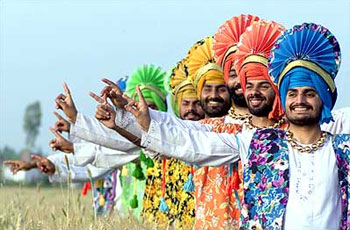
Easter (Across India)
April 4
Although Easter is celebrated all over the country, Goa is considered to be one of the most popular Easter holiday destinations in India. Expect lots of celebrations in this former Portuguese colony with song, dance and carnivals.
Baisakhi (Punjab)
April 14
It is a festival that marks the solar new year and the sowing of the new crop for most communities in India. The date varies from state to state. Baishakhi falls on April 14 in Punjab and is the Punjabi New Year and the start of the harvest of wheat in the state. The traditional Punjabi dance, Bhangra that is performed on this day all over Punjab is the harvest dance of the state.
Nobo Borsho / Boishakh (West Bengal)
April 14
Nobo Borsho or the New Year is the beginning of the New Year for Bengalis. The month that follows is called Boishakh, an auspicious time for marriages.
It is also perhaps the best time to visit Kolkata because there are tons of fairs being held in and around the city. Of these, the most popular is the Bangla Sangit Mela a music festival that is conducted by the state government.
The thing to do is to get yourself invited to a wedding. That shouldn't be much of a hassle since we Indians are so warm to begin with. Or else you could simply gatecrash into one of them.
Vishu (Kerala)
April 14
This is supposed to mark the first day of the Malayalam year and is also the harvest festival of Kerala. North Kerala traditionally has seen more fireworks and celebrations than the rest of the state. However it's always great to be in a place of festivities in any part of the world, isn't it?
Bohag or Rangoli Bihu (Assam)
Mid-April
This festival marks the new year, beginning of Spring and is also an agricultural festival of Assam. Cattle is worshipped and festivities include paying homage to elders and having meals consisting of Chira, curds and sweets.
Bohag Bihu is one of the three Bihus that celebrate the three seasons -- spring, summer and winter.
Chitra Festival (Madurai Temple, Tamil Nadu)
From April 14
Chitra Festival at the Madurai Temple commences on April 14. A showy festival that lasts for nearly a fortnight, it begins on the Tamil New Year. Chitra celebrates the marriage of Meenakshi to Shiv and brims with pomp. Festivities include a spate of dramas depicting Meenakshi's life history.
On the eighth day a procession of elephants and chariots transport the nuptial pair through the town streets and to the banks of the Vagai River to meet Meenakshi's brother Lord Kallalagar (an avatar of Vishnu) who is transported there from his hilltop abode at Algarkovil, outside Madurai. This ceremonious meeting -- the logistics of which are mind-boggling -- has more than its usual quotient of Indian-style pandemonium.

Sikkim Flower Festival (Sikkim)
Held near White Hall, the governor's residence in Gangtok, the flower show displays some of Sikkim's famous orchids, gladioli, roses, alpine plants, ferns, rhododendrons etc. A food festival, river rafting and Yak safaris are other attractions at the festival.
Moatsu Mong (Nagaland)
First week of May
North-East India is arguably the most untouched part of the country. Rituals of the seven sister states are unknown to most Indians.
Moatsu Mong provides a great opportunity to give you a glimpse into an aspect of the culture -- that of Nagaland. The Sping festival usually falls in May and goes on for over six days. Folk dances, songs, tribal chants and indigenous games are all part of this festival -- a must-see for all city-bred folks who think their city limits are the end of the world.
Ooty Summer Festival (Ooty, Tamil Nadu)
May
Pretty much like most other summer festivals, the Ooty version has the regular cultural programmes that include fashion shows, flower arrangement exhibitions, boat races and the works. Visit the Botanical Gardens for the spectacular flower show.
Critics of the hill station will probably tell you that the place is getting to be crazily crowded. But hey, tell us a city that isn't!
Buddha Purnima (Bodh Gaya, Bihar)
May 27
Bodha Gaya is the place where Buddha attained Nirvana. It is a prominent Buddhist tourist spot and is the most sacred of the four Buddhist pilgrimage sites in the country -- the other three include Sarnath (Uttar Pradesh), Sanchi (Madhya Pradesh) and Ajanta (Maharashtra).
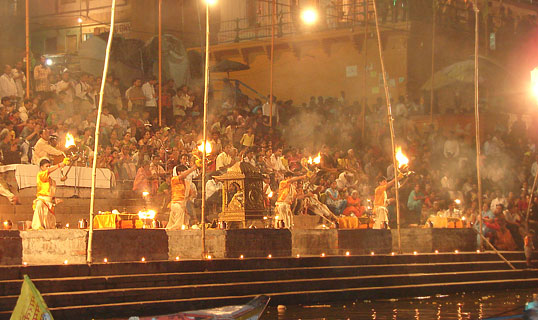
This is an important music festival. The location of the festival in the snowy Himalayan towns of Badrinath and Kedarnath makes the event quite memorable.
Ganga Dusshera (Varanasi and Haridwar)
June 11
Glenn Beck might've called Ganga a disease. Sure the river's been polluted quite a bit but the Ganges will always remain India's most favourite river. Celebrating it's descent and presence on earth, folks in Varanasi, Haridwar, Prayag, Rishikesh etc celebrate the Ganga Dusshera along the river's banks. For ten days there are celebrations, pujas and aartis performed as a mark of respect for the holy river. How's that for a disease, Beck?
Shimla Summer Festival (Shimla, Himachal Pradesh)
Early June
A time for celebrations and cheer in what used to be the summer capital of India during the days of the Raj. The Shimla festival has something to offer for everyone. Popular singers and local artistes rub shoulders here and fashion shows, flower display and film festivals are organised for entertainment.
Sindhu Darshan Festival (Leh-Ladakh, Jammu)
Early June
The festival celebrates one of the world's longest rivers -- the Sindhu. Expect some breathtaking cultural festivities that aim to promote peace, harmony and are a celebration of the country called India. As a symbolic gesture performing troupes from across the country carry waters from the other rivers in pots and immerse them in the Sindhu.
Hemis Festival, (Ladakh, Jammu & Kashmir)
June 20
Held in the Hemis Monastery in Ladakh, the Festival is celebrated to commemorate the birth anniversary of Guru Padmasambhava, founder of Tibetan Buddhism. Expect dances, plays and music from drums, cymbals and long horns. For the compulsive shoppers there some exquisite handicraft from the region for sale.
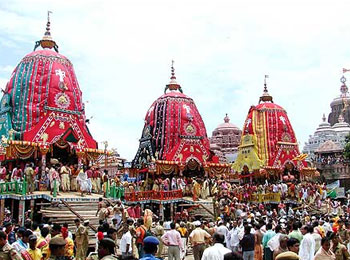
Mango Festival (New Delhi)
It's a dream come true most kids (and many adults too). With over 500 varieties of mangoes on display New Delhi is a paradise for mango lovers. Expect some lip-smacking competitions and some killer mango products at this festival that is held in the capital in July every year since 1987 and is jointly organised by the Delhi Tourism and Transportation Development Corporation, the Agricultural and Processed Food Products Export Development Authority, the National Horticultural Board and the NDMC.
Splash 2010 (Wayanad, Kerala)
First week of July
The Wayanad Tourism Organisation or WTO as they like to call themselves organise a carnival in the Wayanad district of Kerala to promote the area as a tourist destination around the time when the heavens open up.
Apart from the usual song-n-dance festivities by local artistes, you could also try out their adventure sports that include 'mud football', a marathon, a slow cycle race and tons of other fun stuff.
Jagannath Yatra (Puri, Orissa)
July 13 onwards
This is the famous chariot festival of Puri, Orissa. A procession of chariots bearing the presiding deities of the main temple -- Lord Jagannath, Balabhadra and Subhadra are pulled by hordes of devotees to their 'summer cottage' the Gundicha temple, one mile away over a period of 24 hours.
The word juggernaut in the English language gets its meaning from this festival. Music, elephants, royalty, plenty of colour and organised anarchy are a sideshow to this unmissable event which is repeated nine days later when the Jagannath family returns home from their vacation.
Legend has it that the journey of the Jagannath trio symbolises or mimics Krishna's journey -- Jagannath is an avatar or reincarnation of Vishnu, as is Krishna -- from Gokul to Mathura to kill his wickedly powerful uncle, King Kans. Areas of Bengal and Bihar also celebrate their own home grown version of the festival.

Teej (Jaipur, Rajasthan)
August 12-August 13
One of the many colourful festivals of Rajasthan, Teej is celebrated in honour of the reunion of Lord Shiva and Goddess Parvati after a penance of a hundred years. On this day, women dress up and pray for their husband's health and longevity. It also celebrates the rains, which are always welcome in this dry state.
The markets of Jaipur are where you should be heading on this day, to buy clothes and sweets specially made for the occasion as also to witness the processions across the city.
Independence Day (Delhi)
August 15
The day when India awoke to 'life and freedom' in 1947 is celebrated throughout the nation with flag-hoisting ceremonies being held all over. On this day the Prime Minister addresses the nation through a televised speech from the ramparts of the Red Fort in Delhi.
PS: There is no parade and show of the country's military power on this day. Republic Day is when it happens.
Onam and Nehru Trophy Boat Race (Alleppey, Kerala)
August 14 August 23
Onam is the harvest festival of Kerala that celebrates the homecoming of the legendary King Mahabali. Celebrated over 10 days the festivities include folk dance performances, elephant procession and snake boat race.
The Nehru Trophy Boat Race on the Punnamda Lake, near Alappuzha, held on the second Saturday of August every year, is the most competitive and popular of the boat races. On the day of this fiercely-fought boat race, the tranquil lake front is transformed into a sea of humanity with an estimated 200,000 people, many of them tourists, who come to watch the event. For the people of each village in Kuttanad, a victory at this race for their village boat is something to be celebrated for months to come.
Parsi New Year (Mumbai, Maharashtra)
August 19
Although the Parsi New Year is celebrated in various pockets across the country, it is mainly in Mumbai that you can truly experience the celebrations since a good part of the community has made the city their home.
On this day Parsis visit the Fire Temple to offer prayers, which is followed by bhonu or lunch. Traditionally, families also go to watch a Gujarati play in the evening that is put up only for this one day. Usually farcical comedies with tonnes of innuendos the plays are surprisingly watched by almost the entire family.
Entry to Fire Temples in India is restricted only to Parsis though you could watch the play if you really want to be part of the celebrations or simply head to a Parsi eatery in South Mumbai.
Raksha Bandhan
August 24
This is the day when a sister ties a decorated thread on the wrist of her brother who promises to protect her in return. A fairly private ceremony, celebrated in homes rather than in public, it provides a good excuse for all cousins and their parents to get together.
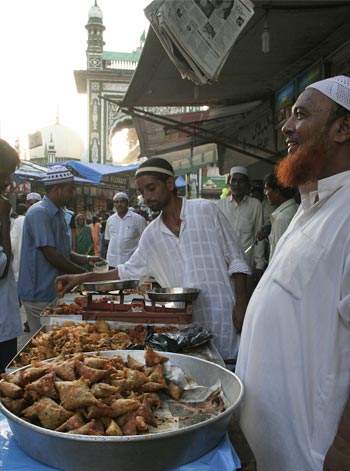
Janmashtami (Across India)
September 2
Janmashtami is celebrated across the country to mark the birth of Lord Krishna. While in the cities of Mathura and Vrindavan see some enchanting performances of the Ras Leela or the Dance of Divine Love, Maharashtra celebrates it by breaking the dahi handi or the earthen pot filled with curd and butter. The pot is tied several feet above the ground and young boys (sometimes girls too) form a human pyramid and reach up to it to claim the prize money.
Id-ul-Fitr or Ramzan (Across India)
August 11 to September 9
The holy month of Ramzan is the ninth month in the Islamic calendar. It is when the followers of Islam refrain from eating or drinking anything from dawn till sunset. After the sun goes down though, the festivities begin with some lip smacking delicacies being made at traditional Islamic eateries. The most delicious food, however, is served on the streets lining the local mosques and shrines like Chandni Chowk-Jama Masjid area in Delhi and Mohammed Ali road in Mumbai.
Ladakh Festival (Leh-Ladakh, Jammu)
September 1-15
Various performing troupes from across Ladakh come together for an annual performance and celebrations. The procession passes through the Leh market and finishes at the polo ground. What follows are 15 days of festivities, mask dances and archery and polo competitions.

Ganesh Chaturthi (Across Maharashtra)
September 11
Celebrated in honour of Lord Ganesha, the festival gained importance during India's freedom struggle when the Bal Gangadhar Tilak used it as a cover for rebels' meeting. The festival, which begins with the bringing of clay images of the deity ends with the immersion on the tenth day. However certain households and public Ganesha idols are immersed on the second, fifth and the seventh days too. Pune and Mumbai are considered to be the hubs of this festival and you can expect a lot of traffic jams during this period.
Tarnetar Mela (Tarnetar near Rajkot, Gujarat)
September 11 to September 13
It might be a quiet hamlet for most part of the year. But come September and Tarnetar in Gujarat turns busy as a beehive. The mela is held in honour of Lord Shiva at the Trineteshwar Mahadev temple.
According to the Mahabharat, Arjuna performed the Matsyavedha (an archery feat) during Draupadi's swayamvara at this temple. Ever since, Tarnetar has been known for its swayamvara, where a girl has the right to choose her life partner. This tradition continues in the Bharwad community. Folk music and dances, a large number of stalls selling local handicrafts, magic shows, joy rides and camel rides are the other attractions at the fair.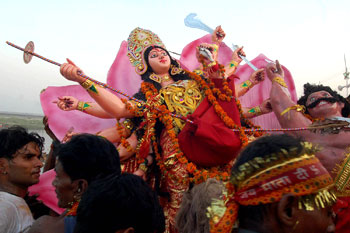
Urs Ajmer Sharif (Ajmer, Rajasthan)
October 1-October 6
Celebrated in honour of the Sufi saint, Khwaja Moinuddin Chishti, the Ajmer Sharif shrine sees a lot of celebrations where devotees of different faiths come here from far and wide to pay their respects and listen to divine quwwalis and sufi songs sans the techno beats in the night. Shoppers keep an eye open for local woven and block printed fabrics!
Gandhi Jayanti (Across India)
October 2
Mohandas Karamchand Gandhi was born on October 2 in Porbunder, Gujarat on this day. Gandhi Jayanti is celebrated with commemorative events in the memory of the Father of the Nation.
Commonwealth Games (New Delhi)
October 3 to October 14
The 19th Commonwealth Games will be held in the nation's capital and will be the largest multi-sport event to be held in the country. The ceremony will take place at the Jawaharlal Nehru Stadium.
Durga Puja (West Bengal and parts of Bihar)
October 8-October 16
In Bengal and parts of Bihar, the nine days leading upto Dasshera are devoted to the worship of Durga, an avatar of Parvati, Shiva's consort. The festival rejoices her victory over the buffalo-headed demon, Mahishasura, after a nine-day battle.
Every street corner or tiny village puts up its own clay image of Durga riding a tiger. It is the most important festival of Bengal with much feasting and merriment. The beautiful pandals put up in every neighbourhood of Kolkata are famous. The festival reaches its high point in Kolkata on the tenth day when the images are taken to the Hooghly River for immersion.

Navratri (Gujarat and Mumbai)
October 8-October 16
In Gujarat and among Gujaratis in Mumbai, this is the festival of nights.It is celebrated during the nine days preceding Dasshera and is the occasion for folk dances or dandiya raas or garba dances.
There are many variations of these dances, and today many are done in accompaniment to Hindi film music and laser images. Navratri honours the goddess of strength, Amba among other goddesses. This festival is celebrated in south India, as well, with puja and fasting and night vigil. It lasts for nine days during which pujas devoted to the goddesses of strength, wealth and knowledge are conducted.
Dusshera (Across India, especially Delhi and Mysore)
October 17
Vijay Dashmi or the 10th day of Dusshera is a day of rejoicing the victory of good over evil, when Rama, hero of the mythological epic Ramayana, defeated and killed the demon king Ravana with the aid of the monkey king, Hanuman. It is celebrated by burning paper and wood statues of Ravan. Don't miss the Ram Leela performances -- plays depicting the life of Rama, in Delhi and Varanasi.
The Mysore Dusshera is held in the Mysore Palace Grounds. Musicians perform on the grounds and the palace is thrown open to the public. A special fireworks extravaganza, also the highlight of the evening, follows.
At the one-week Kullu Dusshera fair, celebrations include a rath yatra and folk music and dance performances.
Bharat Milap (Varanasi, Uttar Pradesh)
October/November
It is supposed to be the day when Lord Rama was reunited with his brother Bharata after 14 years of exile in the Hindu epic Ramayana.
The festivities attract a lot of devotees from all over India with the star attraction being the local maharaja participating in full costume riding an elephant!
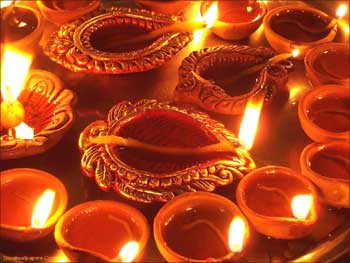
Dhanteras
November 3
In North India, two days before Diwali, it is obligatory to buy gold. Bazaars everywhere are crammed with exotic jewellery even as the prices of gold hit an all-time high.
Diwali
November 5
Diwali or Deepavali signifies deepa or lights and avali or row and hence a 'row of lights'.
It is an extravagant and lavish pageant of lights and firecrackers, worth fitting into a travel itinerary, especially if one is in Rajasthan, Delhi or Gujarat. Every home is lit up with oil lamps, in the manner that Ayodhya was lit up for the return of Lord Ram.
Lakshmi puja (worship of goddess of wealth and consort of Lord Vishnu), feasting, gambling and decorating the home with rangoli, is the order of the day.
In South India Diwali is a celebration of the death of demon Narakasura by Lord Krishna. Mythological demon-king Narakasura had managed to wangle out of Brahma and Shiva because of the boons he received and had grown powerfully evil. The devas or the gods requested Lord Krishna to annihilate him, which he did at Dwarka.
New Year
November 7
For the business community in northern and western India, the Hindu new year starts the day after Diwali. A special puja is performed in offices across the country and financial records begin anew on this day.
Bhaiduj
November 7
It is another festival for brothers and sisters marked by exchange of sweets and gifts.
Maha Kanda Shasti Utsavam (Across Tamil Nadu)
This festival is celebrated in the six temples or abodes of Lord Murugan -- Tiruchendur (temple near Thirunelveli), Thirupparankunram (temple near Madurai), Palani hill temple (Dindigal district), Swami Malai (near Kumbakonam), Thiruthanigai (near Chennai) and Pazhamudhir Solai (near Madurai). Lengthy bouts of bursting fire-crackers, feasting, dances make this one of the largest festivals in this southern state.
Chhat Puja (Across Bihar)
November 11
This holiday is one of the biggest in the state of Bihar, and is a festival for married women. It entails worship of the sun and is also called Surya Puja. Women gather before dawn and wade waist deep in rivers across Bihar, with sweets, grain, fruit and puja paraphernalia like incense and holy water, to fete the sun. The process is repeated again in the evening. Over the years, the Chhat festivities have extended to pockets of the country, which have strong Bihari population such as Mumbai.
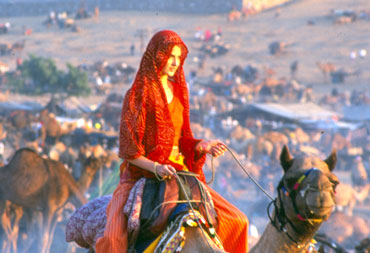
Pushkar Camel Fair (Pushkar, Rajasthan)
November 13 to November 21
Held in Rajasthan, Pushkar is India's most famous camel fair and coincides with Kartik Purnima or a special full moon. Thousands congregate for this colourful mela, traders and tourists alike. It is an occasion for much singing and dancing, folk style. Camel races, handicraft bazaars, fireworks are the order of the day. Special tent facilities are provided for tourists.
Children's Day
November 14
The birth anniversary of Jawaharlal Nehru and India's first prime minister is celebrated across the country's schools because of his love for children. In New Delhi, there is a special fair for children at the India Gate and programmes are organised at the Dolls Museum, Bal Bhavan and at Teen Murti Bhavan, Nehru's home.
Garhwal Festival (Uttarkashi, Uttarakhand)
Mid-November
It is a cultural affair that toasts the culture of the Garhwal hill people, held at Uttarkashi. Celebrate with these simple people living in the lap of the Himalayas as they sing and dance their blues away.
Lucknow Festival (Lucknow, Uttar Pradesh)
Late November
A fortnight of cultural events, food festivals and handicraft bazaars that highlight the splendour of Lucknow, this festival is organised by Uttar Pradesh Tourism. Also witness and participate in traditional village games, kite flying, cock-fighting matches through the fortnight.
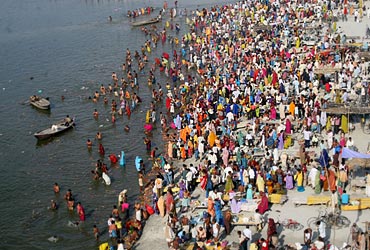
Ganga Mahotsav (Benaras, Uttar Pradesh)
November 17-November 21
This is a time for festivity along the banks of the Ganga in Banaras or Varanasi, the city said to be 'perched on the edge of time'. While it continues to be an auspicious festival, the Ganga Mahotsav is a great symbol of cultural melting pot with people from various classes, castes, religions and nationalities come together to worship the Ganges.
The high point of the festival are the evenings when earthen lamps on lotus leaves are set afloat on the river.
Guru Nanak Jayanti
November 21
This is the biggest day for the Sikh community in India. On this day saint Guru Nanak was born. The festival is celebrated by taking out processions and prayer readings from the sacred granth or holy book. Amritsar is a special place to be on this day.
Sikkimese New Year (Sikkim)
Late November-Early December
Celebrating end of the harvest season, the Sikkimese New Year or Losoong begins each year in the tenth month of the Tibetan calendar. Religious festivities, exuberant celebrations and dances with people dressed as gods are part of the celebrations.
Places to be in Sikkim during this time of the year include the monasteries at Tsuklakhang Palace, Phodong and Rumtek Monastery.
Sonepur Mela (Sonepur, Bihar)
November
This is the world's largest cattle fair. Sonepur, a town located at the confluence of the Gandak and Ganga rivers in Bihar comes alive during this festival, which is timed to coincide with Kartik Purnima or a special full moon. Thousands -- pilgrims, traders and tourists -- converge for the trade of cattle and grain and to witness the drama, music, contests, shows and to shop.
Mythology has it that Sonepur was the historical location of a war between the king of the jungle and the king of the waters -- the elephant and the crocodile. Elephants too are still traded at the fair. For the devout and the non-materialistic, bathing on Kartik Purnima in the river and puja at Hariharnath temple is routine.
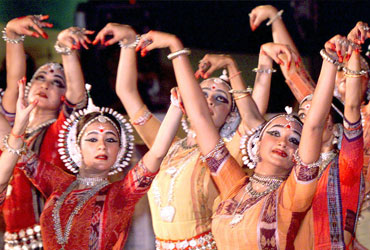
Chandrabhaga Fair (Jhalawar, Rajasthan)
Late November
This fair is a special event in the town of Jhalawar in Rajasthan. Celebrations involve bathing by the devout at full moon or Kartika Purnima in the Chandrabhaga River and puja at the many beautiful ancient temples that line the river.
Guru Tegh Bahadur's Martyrdom Day (Amritsar, Punjab)
November 24
On this day in 1675, Mughal Emperor Aurangzeb killed the Sikh leader in Chandni Chowk after he refused to convert to Islam. A religious procession is taken out in Amritsar, the city of Golden Temple along with the Guru Granth Sahib (the holy scripture of the Sikhs) in a golden palanquin.
Annual Winter Sports (Kufri, Himachal Pradesh)
November
Despite its largely tropical climate, India has much to offer thanks to its geographical diversity. Head to Kufri in Himachal Pradesh this November to get a taste of winter adventure sports in India. Kufri, which is quite close to Shimla, has a wide range of slopes for beginners, intermediate and advanced skiers.
Qutab festival (Delhi)
November/December
The three-day Qutab Festival is organised by Delhi Tourism in order to 'preserve and present the rich tradition of Indian music, contemporary as well as classical'. Some of the best names from the Indian dance and music fraternity gather here to perform with the Qutub Minar as the backdrop.

Konark Festival (Konark, Orissa)
December 1-December 5
This is the place to be if you're a fan of Indian performing arts. Artistes from across the world practicing Odissi, Bharatnatyam, Kuchipudi, Kathak and a host of other classical and folk dances perform at the Sun Temple at Konark each year. This year happens to be the 25th anniversary of the festival. So you can sure expect some fireworks.
Hanukkah (Cochin, Kerala)
December 1-December 9
India's meagre population of Jews celebrates this festival of lights, which commemorates the purification of the Temple in 165 BC. The tiny declining locality of Jew Town in Cochin, Kerala has perhaps the most atmospheric celebrations of this feast in India.
Feast of St Francis Xavier (Old Goa)
December 3
The feast commemorates the death of St. Francis Xavier, patron saint of Goa. According to legend, after he died the body of this Spanish Jesuit missionary was brought back to India and was found as fresh as the day he was buried. It was then kept in a silver casket in the Basilica of Bom Jesus Church in Old Goa. The feast attracts thousands of Christians across the country and the otherwise quiet old town springs to life.

Bikaner Festival (Bikaner, Rajasthan)
Late December/Early January
A stunning procession of camels walks past the imposing Junagarh Fort. This is followed by camel races and various other competitions involving the ship of the desert. The town also houses the Karni Mata Temple where holy rats are worshipped and on the outskirts is a camel breeding farm. The dates of the festival vary each year. So even though the last festival was held on December 30 and 31, the next one will be held sometime in January 2011.
Kagyat Dance Festival
This is a Sikkimese festival where the major players are the monks who perform dances. Each dance is a skit from Buddhist mythology accompanied by ritual chanting and music. On this day evil spirits are exorcised by burning effigies made from wood, flour or paper.
Christmas
December 25
Churches are decked and nativity scenes are set up at street corners in some cities. While Midnight Mass services are rare because of court orders, Goa, Kerala, Chennai and parts Mumbai and Kolkata as well as the Christian areas of Meghalaya, Mizoram and Nagaland are places where major festivity takes place.
New Year's Eve
December 31
The big cities of India celebrate New Year's Eve with verve. The Gateway of India in Mumbai, Park Street in Kolkata, and many parts of Goa are the scene of much merriment.